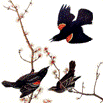Wildlife Damage Management, Internet Center for
Document Type
Article
Date of this Version
10-1983
Citation
Proceedings Ninth Bird Control Seminar, Bowling Green State University, Bowling Green, Ohio, October 4-6, 1983. Ed. William B. Jackson and Beth Jackson Dodd
Abstract
Soybean seeds and cotyledons suffer great damage by the Rufous Turtle Dove in Japan, depending upon the time of seed sowing. In our experimental field at Tsukuba, in 1983, almost all plants were eaten until the middle of May. Doves concentrated in fields where soybean seeds had been planted from the late April to the middle of May. After the middle of May, they came to the fields where wheat and barley had just been cut or the soils had been ploughed. Experiments conducted in the field covered with a large cage and utilizing the same doves showed that the rate of attacking new food (i.e., soybean buds) by doves increased with their experience to eat that food. Doves also frequently return to sites where food had once existed. These results suggest a practical method for avoiding damage by doves: sowing of soybean seeds in fields after the harvesting of wheat or barley. At these times greater effects also will be obtained from bird repellent devices.


Comments
Copyright © 1983 Kazuo Nakamura and Shigeru Matsuoka